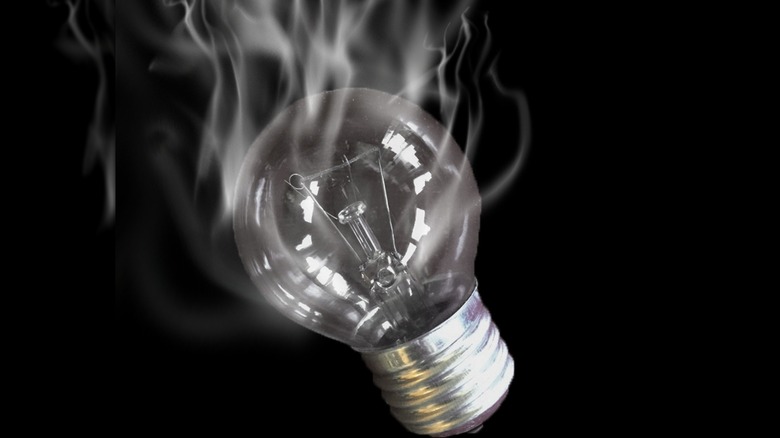No, You Shouldn't Use A Regular Light Bulb In An Oven - Here's Why
If you were to install a regular light bulb in the oven, you run the risk of it failing in the intense heat and shattering, though intense heat isn't the only reason why light bulbs pop or explode. The truth is that certain appliances use special types of bulbs that can withstand more extreme conditions. An oven, for example, often uses incandescent or halogen light bulbs constructed with either heat-resistant aluminum oxide or borosilicate glass. These specialized bulbs operate in environments as hot as 572 degrees Fahrenheit (300 degrees Celsius). Typically, a residential range or wall oven can't exceed 550 degrees Fahrenheit.
A survey conducted by Angi found that 45 percent of respondents keep their homes between 70 and 73 degrees Fahrenheit. Imagine asking your average bulb, which is designed to work in various rooms of the home (often with an ambient temperature in the low '70s), to suddenly adapt to hundreds of degrees hotter.
Beyond greater ambient temperature resistance, a light bulb operating close to food must include some safety considerations. A regular bulb (which isn't designed to be confined next to cooking food) may produce unhealthy byproducts during illumination, whereas specialty bulbs are designed to eliminate this possibility.
Why wattage is important
You should always consult your appliance's manual before changing out the oven light bulb to ensure you get one with the proper wattage. Finding a replacement that simply fits the socket isn't enough to guarantee compatibility. For example, too much power could result in something called "overlamping." A bulb (over the recommended specifications), of which the socket can't output properly, can result in overheating, among other issues, if you use a lightbulb with the wrong wattage. This can lead to damaging the components of the lighting system. Now, instead of simply a new oven bulb, you might require a costly appliance repair.
While going under the recommended wattage doesn't cause anything catastrophic, it can make your oven far too dark to be helpful when cooking. Some dishes, such as a Cheese Soufflé, require frequent monitoring to ensure browning isn't occurring at too quick a pace. A dim oven light makes the process more difficult with reduced visibility, and often opening the oven door for a better view can wreak havoc on temperature-sensitive recipes.
How to properly replace an oven light
When it's time to swap out your old oven light bulb for a fresh one, it's a straightforward and simple process, albeit a bit more awkward than dealing with a typical fixture. Before you do anything, ensure your range or wall oven is powered and hasn't tripped a breaker or become unplugged, leading to a false conclusion that the light bulb needs replacing.
Next, you'll want to unplug the unit and ensure it has had ample time to cool down (if recently used) before locating the bulb inside the oven cavity. Finding the bulb can be challenging, especially without extra light, so you might want to check out some of the best flashlights you can buy on Amazon if you don't have a good one handy. Once located, it might be behind a cover, which you'll need to carefully remove by unscrewing it or releasing a clip holding it in place.
Once you have the bulb in hand, you can then take it with you to the hardware store, ensuring you get a correct replacement. It's best to have the old bulb with you, as once you get to the lighting aisle and see how many variations of similar bulbs are on display, it can be easy to grab the wrong one. Finally, install the new bulb, refasten the cover, and you're done.


